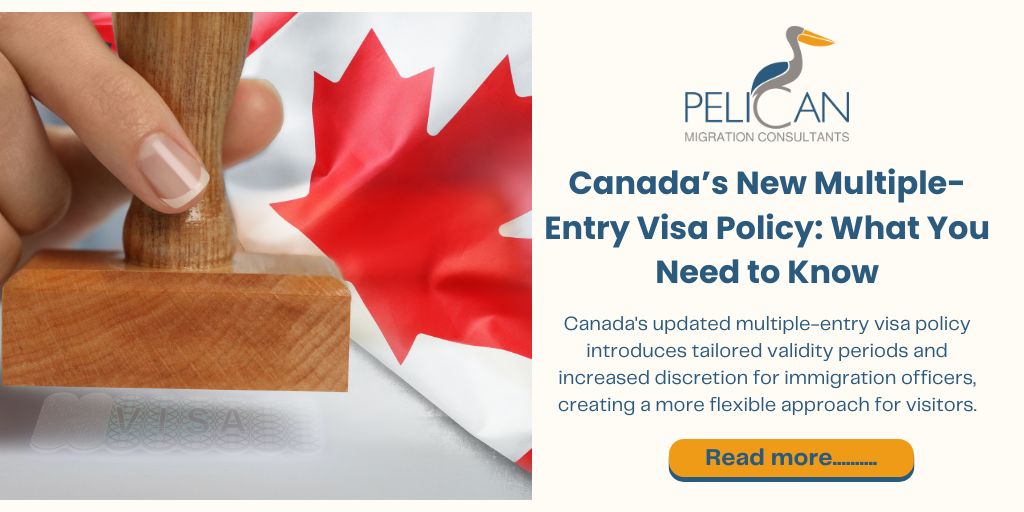
Canada, renowned for its hospitality and diverse attractions, has taken a significant step in refining its visa process. On November 6, 2024, an updated multiple-entry visa policy was introduced, giving immigration officers the discretion to issue visas with tailored validity periods based on individual cases. This shift aims to make the process more adaptive to visitor needs while aligning with Canada’s broader immigration objectives. Here’s a detailed breakdown of what you need to know about these updates.
Overview of Changes in Canada’s Multiple-Entry Visa Policy
Previously, Canada’s immigration framework typically favored issuing multiple-entry visas with the longest possible validity for most visitors. This meant travelers could enter Canada as often as needed until the visa expired. Under the revised policy, immigration officers can now assess and decide whether to issue a single or multiple-entry visa and set its duration based on each applicant's circumstances. This change allows for a more tailored and effective approach to visa issuance.
The main goal is not to limit entry but to ensure that visa validity aligns with visitor intentions and the country’s immigration policies. By evaluating each application individually, officers can grant visas that best fit specific needs, supporting a wide range of travel purposes.
Single-Entry vs. Multiple-Entry Visas Explained
Understanding the key differences between single and multiple-entry visas under this new policy is essential:
- Single-Entry Visa: This type allows the holder to enter Canada only once. If the holder leaves Canada, they would need to reapply for a new visa to return unless their travel is to the United States or Saint-Pierre and Miquelon, followed by direct return to Canada.
- Multiple-Entry Visa: Holders of this visa can enter and exit Canada as many times as they wish without reapplying, as long as the visa remains valid. However, under the updated policy, the validity period can vary based on an officer’s discretion.
Why Did Canada Implement This Change?
Canada’s approach to immigration continues to adapt to changing global and domestic needs. The revised multiple-entry visa policy reflects three main objectives:
- Enhanced Security and Safety: By assessing applications on a case-by-case basis, immigration officers can better identify and manage potential security concerns, ensuring both openness and national safety.
- Efficiency in Visa Processing: Limiting the issuance of long-term multiple-entry visas and aligning visas with specific visitor needs can streamline the process and reduce administrative workload.
- Alignment with Visitor Intentions: This more personalized approach helps Canada cater to a wide variety of visitors, from short-term tourists to frequent business travelers.
What to Expect as a Visa Applicant
For most applicants, the application process remains largely the same—completing an online form, submitting necessary documents, and awaiting a decision. However, the key change is in how immigration officers determine the type and length of the visa.
Scenarios Under the New Policy:
- Tourists and Short-Term Visitors: Those visiting for leisure or brief stays may receive a single-entry visa with an appropriate validity period matching their plans.
- Frequent Business Travelers: Business professionals or those with family in Canada who need repeated entry may still qualify for a multiple-entry visa. The decision will depend on their case specifics and documentation.
- Applicants with Special Needs: For individuals needing medical treatments or academic trips, immigration officers can issue visas that best accommodate their unique circumstances.
Tips for Navigating Canada’s New Visa Process
To navigate the updated policy successfully, applicants can take a few proactive steps:
- Clearly State Your Visit Purpose: Highlight the nature of your visit and the specific visa type required in your application. Supporting documents that clearly outline your travel reasons can strengthen your case.
- Plan for Multiple Visits: If you anticipate multiple trips to Canada, provide documentation that justifies the need for a multiple-entry visa (e.g., business contracts or family connections).
- Be Prepared for Different Validity Periods: Visa durations may vary based on an officer’s decision. Ensure your travel plans are flexible enough to accommodate these changes.
- Stay Updated: Immigration guidelines can change frequently. Stay informed through reliable sources like the Immigration, Refugees and Citizenship Canada (IRCC) website or trusted immigration consultants.
- Seek Professional Help: Consulting with experienced immigration services, like Pelican Migration Consultants, can provide tailored advice to navigate these new guidelines effectively.
How Pelican Migration Consultants Can Assist You
Navigating the intricacies of Canadian visa applications can be challenging. Here’s how Pelican Migration Consultants can make the process easier:
- Comprehensive Assessment: Our team evaluates your eligibility and specific requirements to recommend the most suitable visa type for your situation.
- Document Preparation: We guide you in compiling and reviewing essential documents, ensuring that your application is complete and accurate.
- Application Guidance: Our consultants walk you through the online application process step by step to minimize errors.
- Policy Updates: We stay informed about the latest changes in immigration policies and share these updates with you to ensure your application reflects current requirements.
- Ongoing Support: Whether it’s answering questions or providing additional information, our team is here to support you from the start of your application to the final decision.
FAQs About Canada’s New Multiple-Entry Visa Policy
- What’s the main difference between the new and old policies? The new policy grants immigration officers discretion to tailor visa types and validity periods based on individual cases, unlike the previous focus on long-term multiple-entry visas.
- Can I still get a long-term multiple-entry visa? Yes, but the duration will be determined by the immigration officer based on your specific situation and supporting documentation.
- Will this policy affect processing times? The policy may streamline the process by allowing officers to issue visas that better match applicant needs, potentially reducing processing times.
- What kind of applicants will most benefit from this change? Frequent business travelers, individuals with family ties in Canada, or those with special circumstances may find the flexible approach beneficial.
- How can I increase my chances of obtaining a multiple-entry visa? Clearly stating your visit's purpose, providing thorough supporting documentation, and seeking professional assistance can help strengthen your application.
Pelican Migration Consultants: Your Trusted Partner
When navigating Canada’s updated visa process, Pelican Migration Consultants offer unmatched expertise. Our team of experienced professionals ensures that your application is thorough, accurate, and up-to-date with current guidelines, giving you the best chance at a successful outcome. Trust us to be your guide for a seamless migration experience.


